Super User
Many CDs have been released since the main Discography was last updated in 1996. Please visit the separate page in this website for further information:
Compact Discs of compositions and arrangements Conducted by Robert Farnon
Compact Discs of compositions and arrangements Conducted by Robert Farnon
Including important releases of his music by other orchestras
Full details of all Robert Farnon recordings up to 1996 can be found on the Discography pages in this website.
Some of the Compact Discs listed below have been deleted, but they may still be available from record dealers' stocks. Also copies may be available second-hand through various sites on the internet.
ROBERT FARNON'S SCORE FOR THE 1977 FILM "THE DISAPPEARANCE" is finally available on disc.
For full details on this recent release, please visit the following site:
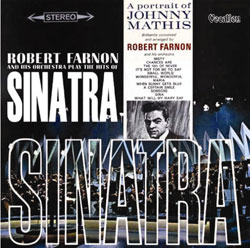 Robert Farnon & His Orchestra
Robert Farnon & His Orchestra
THE HITS OF SINATRA & A PORTRAIT OF JOHNNY MATHIS
THE HITS OF SINATRA
THE ORIGINAL LP SFL 13048 (1965) STEREO
Second Time Around (Van Heusen; Cahn)
All the Way (Van Heusen; Cahn)
Come Fly with Me (Van Heusen; Cahn)
A Lovely Way to Spend an Evening (McHugh; Adamson)
In the Wee Small Hours of the Morning (Mann; Hilliard)
Only the Lonely (Van Heusen; Cahn)
Young at Heart (Richards; Leigh)
Call Me Irresponsible (Van Heusen; Cahn)
(Love is) The Tender Trap (Van Heusen; Cahn)
All or Nothing at All (Altman; Lawrence)
Nancy (With the Laughing Face) (Van Heusen; Silvers)
My Kind of Town (Van Heusen; Cahn)
A PORTRAIT OF JOHNNY MATHIS
THE ORIGINAL LP SBL 7659 (1965) STEREO
Misty (Garner; Burke)
The Twelfth of Never (Livingston; Webster)
It's Not for Me to Say (Allen; Stillman)
What Will My Mary Say? (Vance; Snyder)
When Sunny Gets Blue (Segal; Fisher)
Maria from 'West Side Story' (Bernstein; Sondheim)
Chances Are (Allen; Stillman)
A Certain Smile (Fain; Webster)
Gina (Vance; Carr)
Small World (Styne; Sondheim)
Wonderful, Wonderful (Edwards; Raleigh)
Someone (Kaempfert; Ilene)
Vocalion CDLK 4455
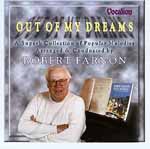 Robert Farnon & His Orchestra
Robert Farnon & His Orchestra
MY FAIR LADY AND OTHER MUSICAL BOUQUETS & THE SENSUOUS STRINGS
MY FAIR LADY AND OTHER MUSICAL BOUQUETS
THE ORIGINAL LP SFL 13047 (1964) STEREO
Get Me to the Church on Time (Lerner; Loewe)
Wouldn't it be Loverly (Lerner; Loewe)
On the Street Where You Live (Lerner; Loewe)
I've Grown Accustomed to Her Face (Lerner; Loewe)
Button Up Your Overcoat (De Sylva; Brown; Henderson)
Black Bottom (De Sylva; Brown; Henderson)
Dancing in the Dark (Schwartz; Dietz)
The Best Things in Life are Free (De Sylva; Brown; Henderson)
I'm a Dreamer, Aren't We All? (De Sylva; Brown; Henderson)
Sunnyside Up (De Sylva; Brown; Henderson)
THE SENSUOUS STRINGS
THE ORIGINAL LP 852011 BY (1962) STEREO
The Touch of Your Lips (Noble)
To a Young Lady (Farnon)
Isn't it Romantic? (Rodgers; Hart)
La Casita Mia (Farnon)
Moonlight Becomes You (Van Heusen; Burke)
When I Fall in Love (Young; Heyman)
Two Cigarettes in the Dark (Pollack; Webster)
I'm in the Mood for Love (McHugh; Fields)
Hey There (Adler; Ross)
Something to Remember You By (Schwartz; Dietz)
Just a Memory (De Sylva; Brown; Henderson)
Alone Together (Schwartz; Dietz)
Vocalion CDLK4462
Mike Dutton, of the UK Vocalion label, has been responsible for restoring almost all of Robert Farnon's early recordings to availability in recent years. Farnon fans owe him a deep debt of gratitude for making available once more those glorious 1950s sounds on Decca, but there has been a gap waiting to be filled regarding the 1960s -; until now.
Surprising the copyright owners have shunned the 1960s Philips LPs for decades, despite false hopes being raised on a few occasions. For years it had seemed to RFS members that the pairing of Bob's Sinatra and Mathis collections was a 'natural' for reissue, but it has taken until late 2011 for this to happen. Mike Dutton has now obliged, but he has gone one step further, by reissuing the 'My Fair Lady' and 'Sensuous Strings' albums as well.
Readers will not need reminding that these two CDs contain fine examples of Farnon's mastery of string writing, as well as his instinctive feel for the swing era that played an important part of his upbringing. What stands out today, is that these recordings do not sound dated: they could have been recorded a month or two ago, such is the timeless quality of beautifully crafted music such as this.
A long held appreciation of Farnon's work must have been the main reason why Quincy Jones signed him up to make a series of LPs for US Philips, a division of Mercury Records, also released in Britain by Philips. This produced five outstanding orchestral albums, the first of which was "The Sensuous Strings of Robert Farnon", released in October 1962. As the title suggests, "Sensuous Strings" focuses on Farnon's mastery of string writing, rather than his command of the full forces of a modern concert orchestra.
The sessions took place on 10 and 11 May 1962 at the Cine-Tele Sound (CTS) studios then situated at 49-53 Kensington Gardens Square in Bayswater, London. In some ways Farnon was thumbing his nose at Decca for their failure to fully promote his work while under contract with them, because these were new stereo recordings of numbers that had previously appeared in mono on various LPs of the 1950s.
In JIM 18 (August 1962) David Ades reported on the final session on the evening of 11 May, which he was able to attend. David wrote: "The first tune played at my visit was Just A Memory and it took well over an hour before everyone was satisfied with the result. The other three tunes -; When I Fall In Love, Hey There and To A Young Lady -; were recorded with very little trouble. Of these, To A Young Lady was the most memorable for me. It was about 9:40 and the session was due to end at 10:00pm. Only the string session and a flautist were left in the studio, and the almost haunting quality of the flute introduction had everyone in the control room amazed. The first 'take' was perfect, but with a few minutes left it was decided to play safe and have another run-through. This second performance turned out to be one of the few occasions when it has been possible to improve upon perfection!"
David also spoke with producer Quincy Jones: "Quincy Jones, A & R Manager for Mercury Records, couldn't hide his enthusiasm for Bob's music. 'I'd like to record fifty albums with him!' he told me." Douglas Gamley was also present, sitting with the balance engineer and closely checking the score to make sure that all the notes were finding their way on to the tapes.
Although the emphasis was on strings, Farnon makes subtle use of occasional woodwinds and brass. It is also good to hear two of his own compositions, the afore-mentioned To A Young Lady (dedicated to his daughter Judith) and La Casita Mia, blending perfectly with the standards making up the rest of the collection. On numerous occasions we hear the sublime violin of Raymond Cohen, for many years Farnon's concertmaster.
In later years Robert Farnon's recording sessions would be regularly reported in Journal Into Melody, but a glance through back issues in the 1960s reveals very little about the other sessions that Bob did for Philips. There were actually five instrumental LPs, the one still awaiting reissue being "Captain From Castile and other Great Movie Themes". This could be paired with the "Shalako" soundtrack, and we have suggested this to Vocalion. Will there be some good news to report about this one day soon?
This report is taken from 'Journal Into Melody', issue 191, March 2012.
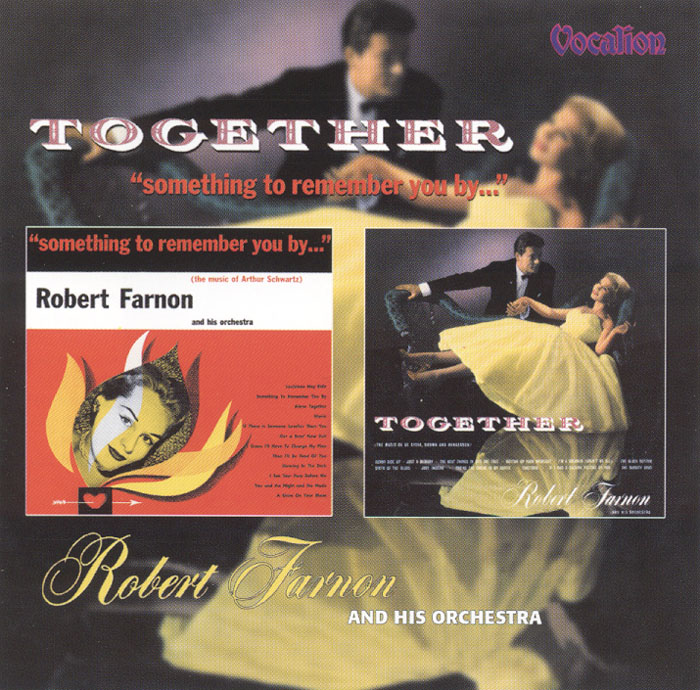 Issued to coincide with 55th Anniversary of the Robert Farnon Society in 2011
Issued to coincide with 55th Anniversary of the Robert Farnon Society in 2011
ROBERT FARNON (1917-2005)
"Captain Horatio Hornblower, R.N." Suite (1951)
1 Introduction: HMS Lydia
2 The Wind
3 Polwheal
4 Lady Barbara
5 Natividad
Rhapsody For Violin And Orchestra (1958)
6 Lento
7 Andante – Allegretto scherzando
8 Larghetto tranquillo
THE LONDON FESTIVAL SYMPHONY ORCHESTRA
Conducted by ROBERT FARNON
Solo Violin: RAYMOND COHEN
RFS CD2
The Robert Farnon Society is proud to be making available again an important 1959 recording, originally issued on a British LP in 1960. It features two works which proved to those familiar with his short cameos such as "Jumping Bean" and "Portrait Of A Flirt" that Farnon was capable of composing more substantial works when the occasion arose. Robert Joseph Farnon was born in Toronto, Canada, on 24th July 1917. While still in his teens he became a familiar name on local radio, but he wanted to move away from the popular music that was paying the bills and spent three years working on his first symphony, which was premiered on 7th January 1941. A second symphony followed a year later, but the Second World War interrupted his plans and, in 1944, he arrived in Britain as Captain Robert Farnon, conductor of the Canadian Army Band.
He remained in Britain after the war and found himself in demand for radio and television broadcasts, the composition of production music, numerous commercial recordings and film scores.
Following the termination of his exclusive contract with Decca, he conducted a large number of top session musicians and players from leading London symphony orchestras for these recordings under the title ‘The London Festival Symphony Orchestra’.
Robert Farnon died on Guernsey on 23rd April 2005 aged 87. The two works on this CD are fine examples of his mastery of composition and orchestration, but they represent only a fraction of the considerable body of work he accomplished during his lifetime.
"Captain Horatio Hornblower, R.N." (Suite)
In 1951 Warner Brothers commissioned Robert Farnon to compose the score for their major British feature "Captain Horatio Hornblower, R.N." starring Gregory Peck and Virginia Mayo. The subject was an exciting sea story in the finest swashbuckling tradition and it gave Farnon on the opportunity to indulge his passion for writing music descriptive of the sea. To get himself in the right mood he spent several weeks on the south coast of England soaking up the atmosphere, in much the same way Debussy had done many years earlier when composing "La Mer".
This suite (prepared by Farnon several years later) is faithful to the original soundtrack score. It requires a large symphony orchestra, with added French horns and brass, and this is evident from the very beginning with the dramatic main theme.
From this develops the beautiful flowing melody descriptive of Hornblower’s frigate "HMS Lydia".
The third movement begins with the theme for Hornblower’s servant Polwheal, based on the traditional British naval air "Portsmouth". This proceeds to the main love theme for "Lady Barbara" which Farnon used later as a separate orchestral work. The final movement covers the exciting battle scenes against the French, with the Lydia theme emerging triumphant.
Robert Farnon conducted the Royal Philharmonic Orchestra in a later recording of this suite in 1991, but many admirers still regard this 1959 one as being preferable.
Rhapsody for Violin and Orchestra
This Rhapsody is regarded by many of his admirers as the finest of Robert Farnon’s more serious works. It was commissioned by the BBC and received its first performance (in an abridged version) at London’s Royal Festival Hall on 7th June 1958 as part of the BBC’s Light Music Festival, an annual event for many years. It was written especially for Raymond Cohen (1919 - 2011), and was premiered by the BBC Concert Orchestra, conducted by the composer. In 1959 Mr. Cohen made the first recording of the entire work, which was also widely performed and recorded by the Canadian Steven Staryk. Shortly after the Second World War Raymond Cohen entered, and became the first winner of, the prestigious Carl Flesch International Violin Competition. He went on to establish an international reputation as a soloist, playing with eminent conductors and orchestras all over the world. In 1959 he was invited by Sir Thomas Beecham to be his concertmaster and solo violinist, a position he held with distinction for six years. He had a long association with Robert Farnon, being his leader and solo violinist for recordings and concerts for many years. He played a Stradivarius violin dated 1703. In August 1991 Robert Farnon and Raymond Cohen made a further recording of the Rhapsody for an American record company, but it is generally accepted that the original recording, which we have here, is the definitive version.
David Ades
This CD is only available from The Robert Farnon Society. Please refer to the ‘Robert Farnon Society Compact Discs’ pages on this website for details of how to order.
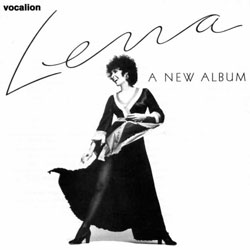 LENA HORNE with ROBERT FARNON AND HIS ORCHESTRA and featuring PHIL WOODS saxophone: "Lena – A New Album" I’ve Grown Accustomed to His Face, Someone To Watch Over Me, My Funny Valentine, Someday My Prince Will Come, I’ve Got The World On A String, Softly As I Leave You, I Have Dreamed, A Flower Is A Lovesome Thing, I’ve Got To Have You, My Ship Vocalion CDLK 4342, 43:03 mins. Last February Mike Dutton asked me to pen some notes for this reissue of an album which – I must confess – I hadn’t listened to carefully for several years. To say it was a magical experience is something of an understatement. Around that time, in the mid-1970s, we were in the happy situation of receiving a steady supply of new Farnon albums, each one containing some priceless gems. To coin a familiar phrase, it was like being let loose in a sweet shop; there were so many treats all around that you didn’t always realise how wonderful some of them really were. I am facing the same situation today when I make selections for the Guild Light Music CDs. I often include individual tracks from Bob’s early Decca LPs (now out of copyright) and in many cases they stand out from the rest. In their original settings, among twelve or so of similar works all receiving his masterly touch, the orchestrations still sounded wonderful – but not as wonderful as they seem today when placed in the spotlight on their own. After several years of negligence I have now returned to the Lena Horne project, and it has been a true revelation. At times I struggled to find the words to express my overwhelming feelings of admiration for the way in which Bob treated each number – the only exception being A Flower Is A Lovesome Thing which Lena’s husband Lennie Hayton arranged. When three unique talents met at London’s Olympic Studios in April 1976, the result was bound to be something rather special. Lena Horne had already been at the top of her profession for almost forty years, beginning with her international fame in great musicals such as "Stormy Weather " and "Cabin In The Sky" (both in 1943), leading to her many concert appearances at the finest venues. She felt equally at home at the plushest nightspots in London, Paris, Monte Carlo, Stockholm, Chicago and New York, and the talented little girl who grew up in Brooklyn never short-changed her legions of doting admirers. By the time she was 16 she appeared at the famous Cotton Club, and this tended to set the tone for her life in show business. Lena was in her element entertaining the diners in nightclubs, yet to the millions who adored her around the world it was her films and recordings that were so magical. Her taste in choosing her material was undoubtedly helped by her marriage to Lennie Hayton, from 1940 to 1953 one of the leading musical directors at M-G-M. The third ingredient in the magical mix of unique talents was Phil Woods, a bebop-influenced alto-saxophonist whose impressive credits included working with Benny Goodman, Quincy Jones, Gene Krupa and Thelonious Monk – to pick just four at random. He honed his craft during four years at the Julliard in New York where he majored in clarinet. Critics and readers of Downbeat praised him with awards, and he received two Grammys around the time that he went into the studios with Lena Horne and Robert Farnon. The bonus of an album such as this is that it allows those involved to express the music in a way that may be completely different from the version that has already become familiar. Divorced from "My Fair Lady", I’ve Grown Accustomed to his Face takes on an almost doleful feel, bringing out the full meanings in Alan Jay Lerner’s lyrics which cleverly convey the realisation that familiarity has moved on to a new, higher plane. Composers must get frustrated when their carefully crafted verses get omitted by singers, but happily Lena Horne does not disappoint in Someone to Watch Over Me. This track marks the first appearance of Phil Woods, far removed from his bebop roots, but his saxophone provides the perfect foil to Lena’s complete grasp of the meanings in the lyrics. My Funny Valentine reveals the Robert Farnon strings in all their glory, with an almost religious feel encompassing the singer who clearly worships her lover. The earlier comment about familiar versions of well known tunes certainly applies to Someday My Prince Will Come. For a while after the release of Walt Disney’s 1937 masterpiece "Snow White and the Seven Dwarfs", Adriana Caselotti’s high soprano frightened off anyone else but by 1976 a new generation had emerged largely untouched by the original, and receptive to a new interpretation. Robert Farnon always knew when simplicity was best, and Lena begins with the intimate sound of Gordon Beck on piano, with the strings gently ushering in Phil Woods as the chorus ends. This is late night music par excellence. The simple theme is maintained in I’ve Got the World on a String with Phil Woods and Gordon Beck supported by Chris Laurence on bass, before the strings eventually shimmer in and alert us to the fact that the lady is about to sing – preceded by a suitable fanfare from the brass. Softly As I Leave You gets the tender treatment it deserves, with the strings providing a heart-rending backdrop before the piano provides just the right touch of perception.I Have Dreamed recreates the jazzy sound of saxophone, keyboard and bass, but the rich orchestral colours are never too distant. Lena’s husband Lennie Hayton provides the lovely string setting for A Flower is a Lovesome Thing, then I’ve Got to Have You is the one track that acknowledges that popular songwriters were still around in the 1970s, although styles had changed quite dramatically. Personally I feel that this is the one number that was out of place in this collection. Kurt Weill composed My Ship for the 1941 show "Lady in the Dark" and it now seems incredible that some bands at the time treated it as an up-tempo number (which you can find on a future Guild CD!), especially when you hear the magnificent setting created for Lena Horne and Phil Woods. Farnon always filled his orchestras with the top session players: his regular Concertmaster, and first violinist, was Raymond Cohen (for whom Farnon composed his "Rhapsody for Violin and Orchestra") and the usual choice of harpist was David Snell, today a leading composer and conductor for films. Each and every performer involved in this album was at their peak when this recording was created in 1976, and the sheer quality shines through in every track. I urge every reader to add it to their collection while they can. If you need an extra incentive, in the booklet there is a colour photo of Bob with Lena relaxing during a break in the sessions. David Ades
LENA HORNE with ROBERT FARNON AND HIS ORCHESTRA and featuring PHIL WOODS saxophone: "Lena – A New Album" I’ve Grown Accustomed to His Face, Someone To Watch Over Me, My Funny Valentine, Someday My Prince Will Come, I’ve Got The World On A String, Softly As I Leave You, I Have Dreamed, A Flower Is A Lovesome Thing, I’ve Got To Have You, My Ship Vocalion CDLK 4342, 43:03 mins. Last February Mike Dutton asked me to pen some notes for this reissue of an album which – I must confess – I hadn’t listened to carefully for several years. To say it was a magical experience is something of an understatement. Around that time, in the mid-1970s, we were in the happy situation of receiving a steady supply of new Farnon albums, each one containing some priceless gems. To coin a familiar phrase, it was like being let loose in a sweet shop; there were so many treats all around that you didn’t always realise how wonderful some of them really were. I am facing the same situation today when I make selections for the Guild Light Music CDs. I often include individual tracks from Bob’s early Decca LPs (now out of copyright) and in many cases they stand out from the rest. In their original settings, among twelve or so of similar works all receiving his masterly touch, the orchestrations still sounded wonderful – but not as wonderful as they seem today when placed in the spotlight on their own. After several years of negligence I have now returned to the Lena Horne project, and it has been a true revelation. At times I struggled to find the words to express my overwhelming feelings of admiration for the way in which Bob treated each number – the only exception being A Flower Is A Lovesome Thing which Lena’s husband Lennie Hayton arranged. When three unique talents met at London’s Olympic Studios in April 1976, the result was bound to be something rather special. Lena Horne had already been at the top of her profession for almost forty years, beginning with her international fame in great musicals such as "Stormy Weather " and "Cabin In The Sky" (both in 1943), leading to her many concert appearances at the finest venues. She felt equally at home at the plushest nightspots in London, Paris, Monte Carlo, Stockholm, Chicago and New York, and the talented little girl who grew up in Brooklyn never short-changed her legions of doting admirers. By the time she was 16 she appeared at the famous Cotton Club, and this tended to set the tone for her life in show business. Lena was in her element entertaining the diners in nightclubs, yet to the millions who adored her around the world it was her films and recordings that were so magical. Her taste in choosing her material was undoubtedly helped by her marriage to Lennie Hayton, from 1940 to 1953 one of the leading musical directors at M-G-M. The third ingredient in the magical mix of unique talents was Phil Woods, a bebop-influenced alto-saxophonist whose impressive credits included working with Benny Goodman, Quincy Jones, Gene Krupa and Thelonious Monk – to pick just four at random. He honed his craft during four years at the Julliard in New York where he majored in clarinet. Critics and readers of Downbeat praised him with awards, and he received two Grammys around the time that he went into the studios with Lena Horne and Robert Farnon. The bonus of an album such as this is that it allows those involved to express the music in a way that may be completely different from the version that has already become familiar. Divorced from "My Fair Lady", I’ve Grown Accustomed to his Face takes on an almost doleful feel, bringing out the full meanings in Alan Jay Lerner’s lyrics which cleverly convey the realisation that familiarity has moved on to a new, higher plane. Composers must get frustrated when their carefully crafted verses get omitted by singers, but happily Lena Horne does not disappoint in Someone to Watch Over Me. This track marks the first appearance of Phil Woods, far removed from his bebop roots, but his saxophone provides the perfect foil to Lena’s complete grasp of the meanings in the lyrics. My Funny Valentine reveals the Robert Farnon strings in all their glory, with an almost religious feel encompassing the singer who clearly worships her lover. The earlier comment about familiar versions of well known tunes certainly applies to Someday My Prince Will Come. For a while after the release of Walt Disney’s 1937 masterpiece "Snow White and the Seven Dwarfs", Adriana Caselotti’s high soprano frightened off anyone else but by 1976 a new generation had emerged largely untouched by the original, and receptive to a new interpretation. Robert Farnon always knew when simplicity was best, and Lena begins with the intimate sound of Gordon Beck on piano, with the strings gently ushering in Phil Woods as the chorus ends. This is late night music par excellence. The simple theme is maintained in I’ve Got the World on a String with Phil Woods and Gordon Beck supported by Chris Laurence on bass, before the strings eventually shimmer in and alert us to the fact that the lady is about to sing – preceded by a suitable fanfare from the brass. Softly As I Leave You gets the tender treatment it deserves, with the strings providing a heart-rending backdrop before the piano provides just the right touch of perception.I Have Dreamed recreates the jazzy sound of saxophone, keyboard and bass, but the rich orchestral colours are never too distant. Lena’s husband Lennie Hayton provides the lovely string setting for A Flower is a Lovesome Thing, then I’ve Got to Have You is the one track that acknowledges that popular songwriters were still around in the 1970s, although styles had changed quite dramatically. Personally I feel that this is the one number that was out of place in this collection. Kurt Weill composed My Ship for the 1941 show "Lady in the Dark" and it now seems incredible that some bands at the time treated it as an up-tempo number (which you can find on a future Guild CD!), especially when you hear the magnificent setting created for Lena Horne and Phil Woods. Farnon always filled his orchestras with the top session players: his regular Concertmaster, and first violinist, was Raymond Cohen (for whom Farnon composed his "Rhapsody for Violin and Orchestra") and the usual choice of harpist was David Snell, today a leading composer and conductor for films. Each and every performer involved in this album was at their peak when this recording was created in 1976, and the sheer quality shines through in every track. I urge every reader to add it to their collection while they can. If you need an extra incentive, in the booklet there is a colour photo of Bob with Lena relaxing during a break in the sessions. David Ades
Last spring (2006) David Ades was approached by the British company Jasmine Records to discuss the possibility of a 2CD collection of Robert Farnon recordings. Rather than repeat the repertoire which has already appeared on other labels, the early discussions centred on recordings that were new to CD. However, at the same time Jasmine naturally wanted to include some of Robert Farnon’s best known works, so that the collection would have a general appeal – especially in North America where Jasmine is a strong seller. Jasmine is gradually building up an impressive catalogue of light music releases, with recent issues featuring Mantovani, Gordon Jenkins and Hugo Winterhalter.
David suggested that the inclusion of some of Robert Farnon’s soundtracks from the 1940s would certainly appeal to his admirers, especially as they have never before been available on commercial recordings. It was also agreed that many of his Decca 78s accompanying popular singers deserved to be restored to the catalogue, and gradually the concept for this new release began to take shape.
David recommended that Alan Bunting should handle the digital sound restoration, and work on the project began in earnest last autumn. Rather than mix the vocals and instrumentals, it was decided that the first CD would concentrate on Bob’s famous numbers, with four longer extracts from film soundtracks. The second CD concentrates on the Decca singles he conducted – many of them featuring his own brilliant arrangements. The result is a collection that provides a snapshot of his formative years in Britain, with plenty of tracks being reissued for the first time in over half a century – thereby making the release of great interest to existing Farnon fans, as well as those who will be discovering his genius for the first time.
 CD 1 Orchestral and Film Music
CD 1 Orchestral and Film Music
1 Portrait Of A Flirt (Robert Farnon)
KINGSWAY SYMPHONY ORCHESTRA Conducted by ROBERT FARNON
2 Gateway To The West (Robert Farnon)
ROBERT FARNON AND HIS ORCHESTRA
3 Westminster Waltz (Robert Farnon)
ROBERT FARNON AND HIS ORCHESTRA
4 All Sports March (Robert Farnon)
QUEEN’S HALL LIGHT ORCHESTRA Conducted by ROBERT FARNON
5 "JUST WILLIAM’S LUCK" (1947) film soundtrack excerpts (Robert Farnon)
Orchestra Conducted by ROBERT FARNON
6 Peanut Polka (Robert Farnon)
ROBERT FARNON AND HIS ORCHESTRA
7 How Beautiful Is Night (Robert Farnon)
ROBERT FARNON AND HIS ORCHESTRA
8 Melody Fair (Robert Farnon)
ROBERT FARNON AND HIS ORCHESTRA
"SPRING IN PARK LANE" (1948) film soundtrack excerpts
NEW SYMPHONY ORCHESTRA and Chorus
Conducted by ROBERT FARNON
9 Opening titles music: Early One Morning (traditional)
10 The Moment I Saw You (Manning Sherwin, Harold Purcell); closing titles music
11 Proud Canvas (Robert Farnon)
QUEEN’S HALL LIGHT ORCHESTRA Conducted by ROBERT FARNON
12 Manhattan Playboy (Robert Farnon)
QUEEN’S HALL LIGHT ORCHESTRA Conducted by ROBERT FARNON
13 "WILLIAM COMES TO TOWN" (1948) film soundtrack excerpts (Robert Farnon)
NEW SYMPHONY ORCHESTRA Conducted by ROBERT FARNON
14 State Occasion (Robert Farnon)
QUEEN’S HALL LIGHT ORCHESTRA Conducted by ROBERT FARNON
15 Pictures In The Fire (Robert Farnon)
QUEEN’S HALL LIGHT ORCHESTRA Conducted by ROBERT FARNON
16 Jumping Bean (Robert Farnon)
KINGSWAY SYMPHONY ORCHESTRA Conducted by ROBERT FARNON
17 A Star Is Born (Robert Farnon)
ROBERT FARNON AND HIS ORCHESTRA
"MAYTIME IN MAYFAIR" (1949) film soundtrack excerpts
NEW SYMPHONY ORCHESTRA and Chorus
Conducted by ROBERT FARNON
18 Opening titles music: Maytime In Mayfair (Harry Parr-Davies)
19 Journey Into Melody (Robert Farnon)
20 Maytime In Mayfair ballet (Robert Farnon)
21 Dream Dance; closing titles music (Robert Farnon)
CD 2 Robert Farnon and his Orchestra accompanying singers on UK
1 The Fleet’s In (Victor Schertzinger, Johnny Mercer) THE JOHNSTON SINGERS
2 You’d Be Hard To Replace (from "The Barkleys of Broadway") (George Gershwin, Harry Warren)
VERA LYNN
3 Chi-Baba, Chi-Baba (My Bambino Go To Sleep) (Mack David, Al Hoffman, Jerry Livingston)
DENNY DENNIS with THE SONG PEDLARS
4 You Keep Coming Back Like A Song (from "Blue Skies") (Irving Berlin)
BERYL DAVIS
5 Hallelujah (Vincent Youmans, Leo Robin, Clifford Grey)
THE GEORGE MITCHELL CHOIR
6 Maybe You’ll Be There (Rube Bloom, Sammy Gallop)
PAUL CARPENTER
7 Cherry Stones (John Jerome)
LEE LAWRENCE and VERA LYNN
8 Every Time I Meet You (from "The Beautiful Blonde from Bashville Bend") (Josef Myrow, Mack Gordon)
DENNY DENNIS
9 I Am Loved (from "Out of this World") (Cole Porter)
VERA LYNN and THE MITCHELL MEN
10 The Stars Will Remember (Don Pelosi, LeoTowers)
SCOTTY McHARG
11 Goodnight You Little Rascal You (Noel)
ANNE SHELTON
12 Great Day (Vincent Youmans, Billy Rose, Edward Eliscu)
THE GEORGE MITCHELL CHOIR
13 Penthouse Serenade (When We’re Alone) (Will Jason, Val Burton)
VERA LYNN
14 When You Make Love To Me (Jascha Heifetz, Marjorie Goetschius)
PAUL CARPENTER
15 My Resistance Is Low (Hoagy Carmichael, Harold Adamson)
THE JOHNSTON SINGERS
16 Once Upon A Winter Time (Johnny Brandon, Ray Martin)
VERA LYNN
17 If You Ever Need A Friend (Jimmy Harper, Larry Miller)
DENNY DENNIS
18 Kiss The Boys Goodbye (Victor Schertzinger, Frank Loesser)
THE JOHNSTON SINGERS
19 The Way That The Wind Blows (Whitney, Kramer)
BERYL DAVIS
20 In Between The Showers (You’ll Find A Little Sunshine) (McGhee, Walsh, Silberman)DENNY DENNIS
21 I’ll Make Up For Everything (Ross Parker)
VERA LYNN
22 Lovely Lady Let The Roses See You Today (Hardy)
JOHN CAMERON
23 When You’re In Love (O’Connor, Fields, John)
RONNIE RONALDE, whistling
24 A La Claire Fontaine (Traditional, arr. Robert Farnon)
JACQUES LABRECQUE and THE MITCHELL CHORUS
25 "Cinderella" – Walt Disney Film Selection (Mack David, Jerry Livingston, Al Hoffman)
GRACIE FIELDS with THE GEORGE MITCHELL CHOIR
Jasmine JASCD 661
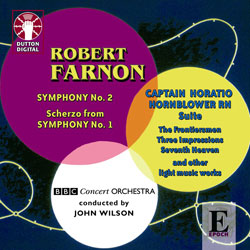 A North American Review of John Wilson and the BBC Concert Orchestra’s superb performance of important Farnon works
A North American Review of John Wilson and the BBC Concert Orchestra’s superb performance of important Farnon works
FARNON "Captain Horatio Hornblower RN": Suite; Symphony No. 2 in B; The Frontiersmen: Overture; Goodwood Galop; Alcan Highway; Three Impressions: High Street, In a Calm, Manhattan Playboy; Seventh Heaven; Playtime; Symphony No. 1 in D - Scherzo. John Wilson conducting BBC Concert Orchestra • DUTTON Epoch CDLX 7173 (76:43)
Among devotees of light music, Robert Farnon (1917—2005), born and trained in Canada, is practically a deity - and with good reason. No other Englishman since the era of Eric Coates has left such a deep mark, with his utterly distinctive and widely influential idiom, on the whole field of light music. In addition to his conspicuous role in this area, however, in jazz and popular music Farnon was an arranger whose talents were sought out by many famous stars of the day - Sinatra, Sarah Vaughan, Tony Bennett, George Shearing, J. J. Johnson, Singers Unlimited, even Eileen Farrell. Beyond this, Farnon also made occasional forays into film music, as the first item on this long-awaited dazzler of a disc triumphantly illustrates - the concert suite drawn from his most famous score for the Gregory Peck 1950s costume drama "Captain Horatio Hornblower RN".
This is the third and by far the most impressive recording of this splendiferous music. Its towering main theme is the quintessence of swashbuckling adventure, and the exquisite "Lady Barbara" love theme is one of Farnon’s most enrapturing inspirations. Perhaps some of the action sequences sometimes sound a little too forced or generic, but Farnon’s absolutely brilliant command of orchestral colours sweeps away all reservations.
Like Montague Phillips of an earlier generation, Farnon, although he was already lead trumpeter in a radio orchestra led by Percy Faith, began his precocious career while still in his early twenties as a composer of large-scale concert music with two symphonies premiered to considerable acclaim under conductors Sir Ernest MacMillan and Eugene Ormandy. In point of fact, Farnon never totally turned his back on the "classical" world; among his later more extended works are a gorgeous Rhapsody for violin and orchestra, Prelude and Dance for harmonica and orchestra, Tripartita for saxophone and orchestra, and a piano concertante piece entitled Cascades to the Sea.
This premiere recording of the Second Symphony, subtitled "Ottawa," together with the Scherzo movement from the First (both products of the early 1940s, before he emigrated to England as conductor of a war time army orchestra), will delight all of those who have waited decades to hear these prime examples of the Farnon style in gestation.
At nearly half-an-hour in length, the Second Symphony is quite ambitious, and its three movements (Larghetto con maesta; Allegro moderato; Largo ma non troppo) show that Farnon was not content to abide by traditional rules of tempo and mood, of which there is considerable freedom and contrast here, even within individual movements. Though perhaps a little weak in the strategies of formal development, the proceedings are dominated by Farnon’s innate melodic gift as well as his instinctive feeling for rich orchestral textures. Already his characteristic modes of soaring expansiveness and celebratory affirmation are clearly evident. In fact, the composer would now and then return to these then-withdrawn scores to mine them for ideas for later works, such as the opening of the finale, which became the spellbinding Ottawa Heights of his "Canadian Impressions". The First Symphony Scherzo—meaningfully marked Moderato con licenza - sports a disarmingly memorable tune which could be a harbinger of light classics like Jumping Bean.
The remainder of this program offers a diversified cross section of the kind of orchestral miniatures for which Farnon discovered in the post-war years there was a strong demand in England. This was a field that made best use of his particular talents, and most were originally published by Chappell as utilitarian "production" music, but many eventually became popular outside of this specialized context. Both Alcan Highway and High Street were later incorporated into "Canadian Impressions", while Manhattan Playboy typifies the breezy metropolitan dash of Portrait of a Flirt, and Seventh Heaven the glamorous and rhapsodic ambiance of Journey into Melody and A Star Is Born. Incidentally, In a Calm is one of the most serene and luminous pieces of quiet music ever devised. In works like these, as well as The Frontiersmen, Goodwood Galop, and Playtime, Farnon can immediately evoke a specific mood or activity in just a few short pregnant measures filled with striking and often cleverly unpredictable melodic, harmonic, and rhythmic outlines that stay in the memory in part due to their masterly orchestral embodiments.
John Wilson, the enormously talented young conductor whose interests straddle both the popular and classical fields, conducts absolutely impeccable and idiomatic performances from an ensemble with more than a passing acquaintance with this kind of fare. And Dutton’s sonics leave nothing to be desired.
It is high time the artificial boundaries between pop and classic are breached, and it is this kind of release that moves the process forward. The music of Robert Famon is an excellent place to start. Quality is quality, no matter what the context.
Paul A. Snook
Reproduced from the American magazine "Fanfare" by kind permission of the reviewer.
Vocalion CDLK4100 From The Highlands / From The Emerald Isle
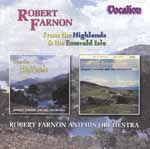 These two LPs feature some beautiful arrangements of traditional airs. "From the Emerald Isle" was Robert Farnon’s first LP in stereo.
These two LPs feature some beautiful arrangements of traditional airs. "From the Emerald Isle" was Robert Farnon’s first LP in stereo.
"From the Highlands": Blue Bells of Scotland/Wi’ a Hundred Pipers/Charlie is My Darling/My Ain Folk; The Campbells are Coming/A Highland Lad My Love Was Born/Annie Laurie; Bonnie Dundee/Barbara Allen; Blue Bonnets Over the Border/Skye Boat Song; Comin’ Thru the Rye/My Love is Like a Red Red Rose; Highland Laddie/Loch Lomond/Green Grow the Rushes; Robin Adair/Ye Banks and Braes; Keel Row/Whistle and I’ll Come to You/My Love She’s But a Lassie/Blue Bells of Scotland. "From the Emerald Isle": Killarney; St Patrick’s Day/The Gentle Maiden; Kerry Dance/How Are Things in Glocca Morra; The Girl I Left Behind Me/Cockles and Mussels; Londonderry Air; The Minstrel Boy; The Irish Washerwoman; I’ll Take You Home Again, Kathleen/The Rakes of Mallow; An Irish Lullaby/The Wearing of the Green; The Mountains of Mourne/Kathleen Mavourneen; Haste to the Wedding/Believe Me If All Those Endearing Young Charms.
Vocalion CDLK4102 Out Of My Dreams
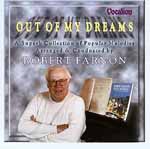 A collection of stereo recordings from the 1970s, originally released in Britain on the small Rediffusion label.
A collection of stereo recordings from the 1970s, originally released in Britain on the small Rediffusion label.
Out of my Dreams, Send in the Clowns, Dream a Little Dream of Me, Michelle, Theme from 'Godfather 2', *Latin Dreamer, Romantic Hour, Street of Dreams, The Way we Were, *In a Dream World, You Stepped out of a Dream, The Sweetheart of Sigma Chi, Liebestraum, Dream, All Alone, I Dream of Jeannie with the Light Brown Hair, Dream Memory, Emmaline, I Had the Craziest Dream, Jo-Anne, My Little Friend, When I Grow too old to Dream, Daybreak, Alice Blue Gown. (*Robert Farnon compositions)

